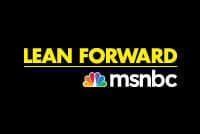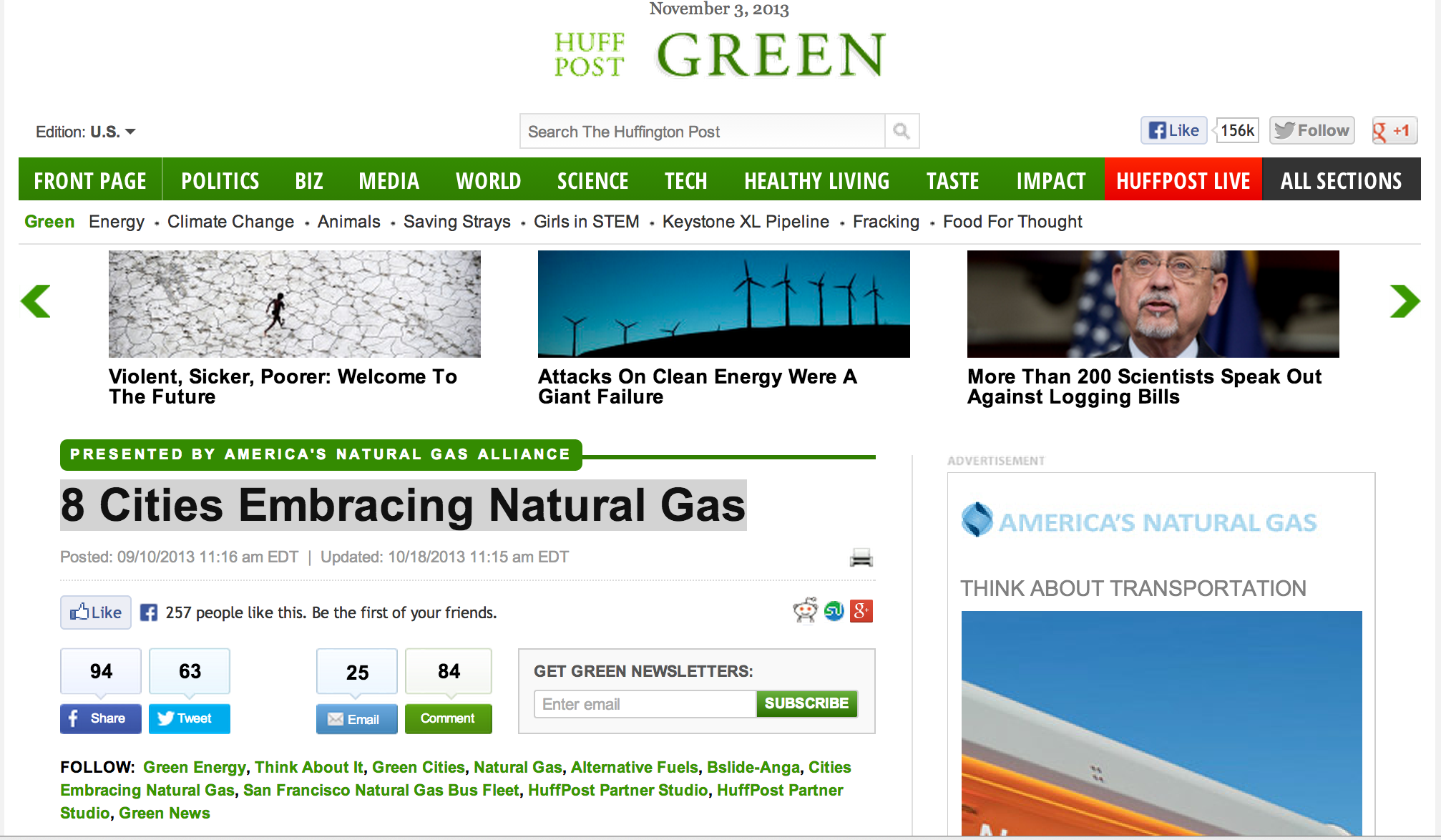Three years into its “Lean Forward” re-branding campaign, MSNBC has given new meaning to the catchphrase, leaning forward into running branded content promoting hydraulic fracturing (“fracking”).
Looking to beef up its web presence, MSNBC has brought “Lean Forward” online with a new and improved website, calling it a “Platform for the Lean Forward, progressive community.” A key part of funding that platform: running “native advertisements” for America’s Natural Gas Alliance and General Electric.
“General Electric and America’s Natural Gas Alliance are the site’s launch partners,” explained an October 30 MediaPost article.
“GE, the first native ad partner for msnbc.com, will collaborate with MSNBC to deliver a content series that highlights how the ‘Industrial Internet’ and ‘Brilliant Machines Innovation’ are reshaping our world. America’s Natural Gas Alliance will be featured in sponsored polls in the ‘Speak Out’ section of the site centered on natural gas facts.”
GE, former owner of NBC, of which MSNBC is one of its many tentacles, is fully invested in the fossil fuel industry, with assets in fracking, coal, offshore drilling, tar sands, and more. ANGA is the shale gas industry’s lobbying tour de force, both at the federal and state level.
Native advertising – also referred to as “branded content” or “native content” – is quickly replacing banner ads and pop-up ads as the go-to channel of reaching consumers for advertising executives.
“Native content is a digital advertising method in which the advertiser attempts to gain attention by providing content in the context of the user’s experience, matching both the form and function of the environment in which it is placed,” explained a recent MarketingWeek article.
If banner ads and pop-up ads are “overt ads,” then native ads are best described as “covert ads,” akin to the controversial “video news releases” for TV news.
“The tricky bit is to not get too focused on traditional marketing and advertising, to integrate the story so that it feels seamless. There has to be a narrative. It can’t just be putting advertising into the editorial mix because then it feels incongruous,” Matt Elek, Managing Director for VICE Magazine said in a recent interview with MarketingWeek.
“The point of native advertising is that it has to be content because if you end up in someone’s newsfeed and you’re advertising, then it can have the reverse effect of what’s intended, they’ll feel tricked into having blatant advertising messages merged in.”
Federal Trade Commission Hearing on Native Ads
It’s the “feels seamless” part of the native ads experience that has garnered the attention of the Federal Trade Commission (FTC).
“[T]he blurring line between editorial and advertising – native ads’ secret sauce – has raised concerns that consumers are being duped. That in turn has caught the eye of the U.S. government,” wrote Ad Age.
On December 4, the FTC will host its first ever workshop on native ads.
“Increasingly, advertisements that more closely resemble the content in which they are embedded are replacing banner advertisements – graphical images that typically are rectangular in shape – on publishers’ websites and mobile applications,” says an FTC press release announcing the workshop.
“The workshop will bring together publishing and advertising industry representatives, consumer advocates, academics, and government regulators to explore changes in how paid messages are presented to consumers and consumers’ recognition and understanding of these messages.”
Advertising industry executives have already expressed concerns rthat egulations could be in the works.
“Part of the fear is that the regulators may ultimately decide that all sponsored content should be labeled because that’s an easy black and white line,” Linda Goldstein, partner and chairwoman for the advertising, marketing and media division at the law firm Manatt, Phelps & Phillips said in a recent interview with The New York Times.
Fusing Advertising with Editorial Content
MSNBC is far from a lonely native advertising bystander, joined in the hustle by the likes of The Huffington Post, BuzzFeed, The New York Times, Associated Press and others.
A case in point: On September 10, Huffington Post Green ran a native ad article titled, “8 Cities Embracing Natural Gas” sponsored by ANGA.
Screenshot Taken on Nov. 3 from Huffington Post Green
“Natural gas fuels cleaner, more efficient power plants, along with fleet vehicles and cars,” the native ad reads. “At the same time, it feeds the growth of our economy by supporting manufacturing and creating jobs. More and more of our nation’s leaders are turning to this domestic energy source to cut pollution and increase efficiency.”
ANGA‘s ads, as seen in the HuffPost example, will not address any of the myriad ecological harms acccompanying fracking.
BuzzFeed Founder and CEO Jonah Peretti – also a co-founder of The Huffington Post – said native ads will be the fuel that runs the machine at BuzzFeed for months and years to come in a memo to his staff posted on LinkedIn:
Part of being a great business, is being a ‘must buy’ for advertisers who have many options. This means giving advertisers the full advantage of our scale, our data, our creative team, our social and mobile reach, and our technology platform. As we do bigger partnerships, it is clear that we can offer brands programs that nobody else can match…And thanks to the amazing efforts of…our talented sales team, we have worked with 50 of the top 100 brands.
In the coming years we will expand BuzzFeed University to train brands and agencies in the ‘BuzzFeed way,’ we will launch a branded video studio in LA to compliment our creative team in NYC, we will grow our partnerships with Facebook and Twitter to expand buys beyond BuzzFeed, and we will develop our social homepages product to power social advertising across the web.
Critics believe the shift toward native ads blurs the line between news and advertising, public relations and propaganda, akin to what the Center for Media and Democracy calls “fake TV news” as applied to video news releases.
“In my mind, this is a perilously close line to blur between the previously sacrosanct distance between editorial and commercial interests,” MarketingWeek opinion writer Ronan Shields wrote in a recent article. “Plus the potential damage such a practice can inflict upon the editorial integrity (in marketing speak that’s brand equity)…is quite worrying.”
Subscribe to our newsletter
Stay up to date with DeSmog news and alerts








